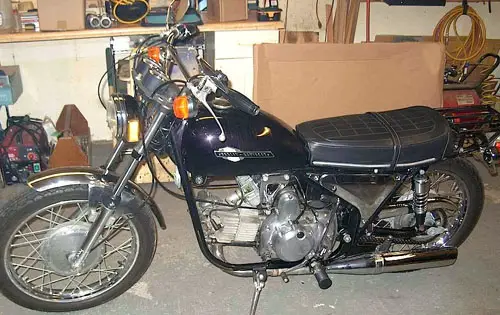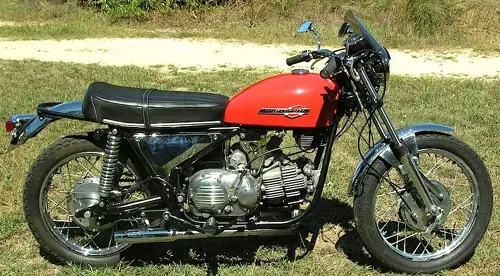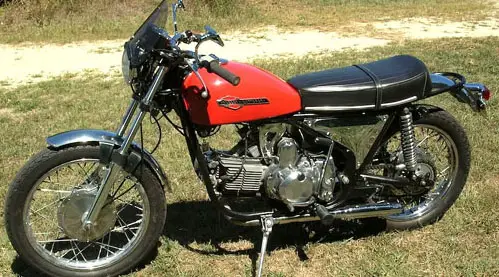|
An Italian-American Affair: 1974 H-D/Aermacchi 350 SS Sprint By Dave Murray The 30-something guy in the F-150 at the stoplight rolled down his window, regarded my small bike, the "Harley-Davidson" tank badge, the single cylinder sounding like a demented popcorn machine and yelled; "What the Hell is that, REALLY?" He obviously thought I had stuck a Harley badge on some lesser bike as a gag. Understandable, really. The last of these bikes were built before he was born. I had sold the Royal Enfield Bullet and the modified Sporty, moving to a Triumph Thruxton. A modern cafe racer, it is fast, smooth, handles lovely and is stone reliable, but there is one itch it doesn't scratch. I come from light bikes and love them for their effortless handling and sensitive feel. I wanted a light single and they are a pretty nearly extinct species these days. I am looking for a reasonably unique bike, but with decent parts availability, somewhat a contradiction in terms. I need to cruise at 70+, which is asking a great deal of a 250. The 350cc class, dominant in Europe, was never popular here. Americans bought 250's to run around town, or they bought 500cc+ for the highway. Of course, it has to make my heart sing in a way no Japanese bike, however capable, has ever done. I'd love a Bevelhead Ducati, but they cost the earth, were rare in the day (about 200 units a year to the US) and parts are unobtanium. I had become pretty frustrated prowling Craigslist and Ebay when I stumbled upon her, a 1974 Harley-Aermacchi 350 Sprint. I had not thought to search "Harley-Davidson", but I remember these bikes. They had a good rep in the day and quite a lot of them were imported, 4000 Sprints alone in 73-74. In the late 50s, The MoCo had seen the Japanese selling large numbers of light bikes, so they bought the Motorcycle arm of Aermacchi, an Italian aircraft builder. They sold these bikes, from 90cc two-strokes to 350cc four-strokes, for fifteen years. Being built in the same factory, by the same people as the aircraft, they were of excellent quality. Can you think of any other company making motorcycles that has ever held the world absolute speed record? (440+ MPH in 1934, a record for piston-powered seaplanes that stands to this day.) Walter Villa won three 250cc and one 350cc World Championships for Harley in the '70s, and Aermacchis are credited with 16 wins on the Isle of Man (BSA has 13). A 350 Sprint took the IOM GP Classic 350cc race in 2010, at a race average of 101 MPH. I did some research and within a couple of hours had found a half-dozen parts suppliers. Every Harley dealer had to stock parts and those parts were bought up when the MoCo lost interest. About 95% of the parts are easily available, either new/old stock or modern manufacture. The bike in the ad was a '74 with 2800 miles (4 owners!), not entirely a good thing. The engine ran well and the transmission was smooth. All the original chrome and alloy were tarnished black, but were not pitted. The original seat was perfect. On the downside, the brakes locked instantly, bottoming the forks, and every painted piece was chipped and battered. The tank had been painted a bilious eggplant purple and the paint was bubbling. It had new tires. I paid his price, which was a bit high. Only Dante could have adequately described the trip to pick up the bike. It involved the Joisey Toinpike, Cross Bronx Expressway and the Connecticut Turnpike; both ways in a rented van, on a summer Saturday. Then followed a month of 10-12 hour days, seven of them a week. (I am retired.) First, I removed a bunch of items that were obviously design afterthoughts. The basic bike is handsome, but only the word "Dorky" can describe the turn signals the size of hockey pucks, the parcel carrier made by a hung-over blacksmith, the high dirt bike bars, the huge lollipop mirrors and the downright agricultural tail light. (I looked to see if it was marked "Massey Ferguson.") I replaced all of them with better looking hardware. One can restore to original condition, which means restoring the mistakes, as well, or do to the bike what one might have done had he bought it new. I did the latter. The basic procedure ain't rocket surgery. You remove an assembly, clean it, fix it, polish or paint it, reinstall and adjust. Then on to the next part. I didn't pull the motor. You can paint the frame quite well, if you're patient, masking with paper and tinfoil to stop overspray. I used Semi-Gloss rattle-can black, as I don't like gloss frames. I painted the tank in the orange-red that Macchi used as their racing color, in catalyzed acrylic enamel. The forks were dry, except for black sludge, so I rinsed them out with naphtha and refilled with fork oil. The brakes were full of rust, which yielded slowly to Scotch Brite. I replaced the cables. The clutch looked new, as did the brake linings. Cleaned the nice little DellOrto square-slide carb. Replaced all the zinc-plated fasteners with stainless steel. Discoveries: Ceriani forks, Tomaselli controls, Radaelli rims, Veglia instruments. The mudguards are stainless and they polished to mirror finish. The motor is impressive for the '60s, wet sump, roller bearing big end, unit construction with geared primary, dry clutch. It's a pushrod motor, but is rated at 7200 RPM and is happy there. In fact, I have to watch it, as it wants to go faster. The racing guys turn over 10,000 with a little modification. As it all came together, I also did a basic Stage 1 upgrade. I replaced the restrictive and inaccessible air cleaner with a velocity stack to get the air in. The bike has a dual exhaust, which is a bit much for a single. I originally replaced the big, restrictive stock silencers with the 12" EMGO Shortys. Since then, I have replaced the whole system with a single racing header, also with a Shorty. This has to be good for a couple of horsepower. When you let more air in (and out), you have to give it more fuel. The stock main jet is 1.25mm, but at the end of my mixture runs, it now has a 1.45mm. That translates to extra power. The wheels went out to my wheel guy. They were out of round, warped like a potato chip and out of balance. No wonder the previous owner said the bike scared him at 50 MPH. Finally, at some time in the past, condensate formed in the cylinder, causing rust, and someone tried to hone it out, leaving a cylinder that was barrel-shaped and egg-shaped to the tune of .015". In went a new cylinder and a new Wiseco piston. Not too expensive at $300. One fine day it was all done, at least for the first stage. Here are the photos, "before" (above) and right and left sides "after" (below): 
It started right up, with the classic single POPOPOP! I took it easy, to break in the new rings, but it was difficult, as this bike just wants to go. OK, it's no Hayabusa, as it has maybe 30 HP, but it is light, 200 pounds lighter than a Sporty, 500 pounds lighter than an Ultra Classic. In fact, the Macchi and the Thruxton together are lighter than an Ultra! You're in first gear for about two seconds, second for about four. Third and fourth are the pullers and then there is a bit of a gap when you drop into fifth, a nice cruising gear. It sure doesn't feel slow. The clutch is perfect, and the shift precise. It will top 80 MPH with my 220 pounds aboard and hold 70-75 happily all day. Still, the bike isn't about acceleration, but handling. If you have not ridden a light Italian bike, you have missed a truckload of fun. It just flows through a series of twisties without effort or drama. There is an element of "Allegro con Brio" there, she's telling me she is having fun. (She tells me her name is "Gina", by the way.) You never find yourself thinking "Hey, I'm a bit wide, better lean on the inside bar." It just happens. I've had a buddy on the Thruxton have trouble keeping up in the tight bits. This on 3.25" front and 3.5" rear tires. Another buddy came back from a ride on her with a huge grin, exclaiming, "Damn, this bike corners horizontal!" The brakes are double leading shoe drums in front, single leading in back. They take more effort than a disc, but they really stop the bike. These were the pinnacle of drum brake design. They will fade, but you really have to work at it. Excellent modulation. Oddities: The kick-start is on the left, bloody awkward. No neutral light, I guess they figured that a true rider doesn't need one and you don't. The reserve fuel valve handle is on the inside of the valve, just about impossible to work with gloves on. That is going to be replaced before it kills me. There it is, a classic bike that is useable and rewarding as a daily rider. It has been reliable and parts are readily available. I'm comfortable on the interstate. Sure, I'd like to have a Velocette Venom, but I'd be afraid to ride it for fear of breaking something unobtainable, not that I could afford one in the first place. I hear a shouted, "What year is that?" at every other stoplight. Young riders walk by without a clue, but older ones gather round. Harley guys, perhaps surprisingly, are all over the bike. We have been to two shows, taken two first places. Go forth and be joyful! |

